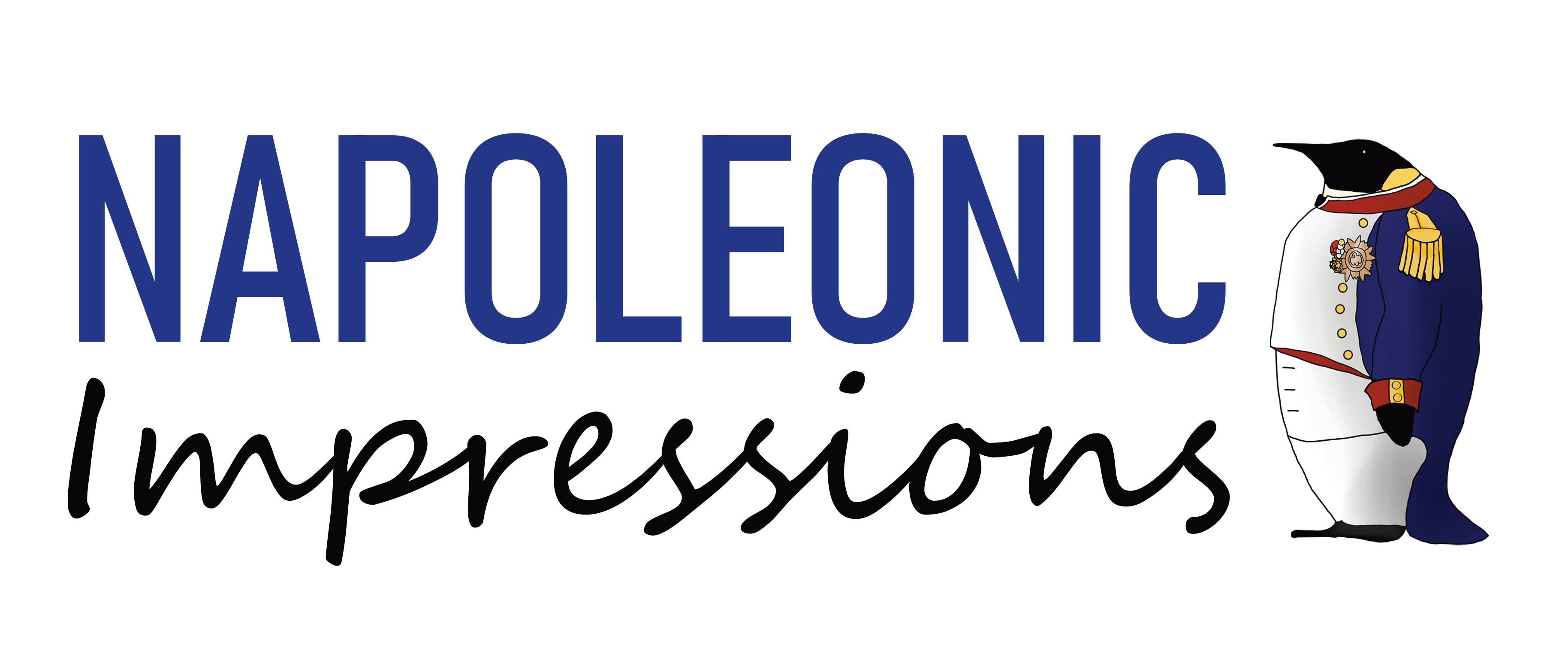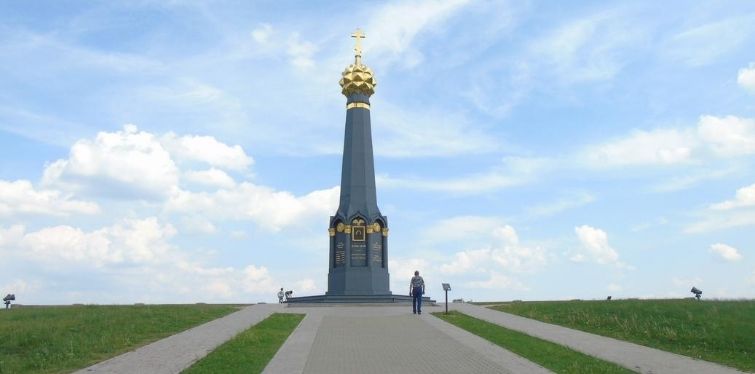This blog post serves as a guide to the major landmarks on the battlefield of Borodino, featuring our photos of the buildings and monuments on the battlefield site. We hope that readers who have plans to visit the Borodino battlefield will find this guide useful. Please also check out our Youtube video on visiting the battlefields of Borodino and Maloyaroslavets.
The Russian centre
The first port of call for most visitors to the Borodino battlefield is the main battlefield museum opposite the Great Redoubt (Raevsky Redoubt). The museum consists of eight rooms offering a narrative of the 1812 campaign. Display cases show battle scenes and visual representations of the leading Russian commanders in the campaign, as well as associated documents and artefacts. Inside the main hall there is a large diorama depicting the battle together with audio-visual commentary. The room also displays uniforms, portraits of Russian generals, and Russian battle standards.
The Great Redoubt stood at the centre of the Russian position and was the scene of heavy fighting between Prince Eugene de Beauharnais’ IV Corps and Russian troops from Raevsky’s VII Corps and Dokhturov’s VI Corps. The octagonal main battlefield monument was unveiled in a grand ceremony in 1839. The remains of Prince Bagration were transferred to the battlefield and reinterred at the foot of the monument.
A path behind the redoubt leads to a group of three monuments around 500 metres away to the east, standing in front of the woods. The first of these is the monument to General Alexei Bahmetyev’s 23rd Infantry Division from Alexander Ostermann-Tolstoy’s IV Corps, which sustained heavy casualties during the battle. Three tombstones in front of the monument mark the graves of four Russian officers killed during the battle. The red granite obelisk honours the Astrakhan Cuirassier Regiment, while the monument topped by a large eagle honours the Horse Guards and Chevaliergardes, the most elite Russian cavalry units. They were among those who took part in the grand cavalry duel behind the redoubt which eventually resulted in the French and Saxon cavalry being driven back by the Russians.
The Russian right
The eponymous village of Borodino lies 1.5km to the north of the Raevsky Redoubt. The main attraction is the Imperial Palace, built for Tsar Nicholas I’s visit to the battlefield in 1839. The building hosts an exhibition about the history of the village and the surrounding area. In 1812, the Borodino estate was owned by the Davydov family, and Denis Davydov, the Russian partisan leader, was brought up here. In addition to the palace, the other major landmark in the village is the 18th century Church of the Smolensk Mother of God (then known as the Church of the Nativity). During the battle French officers climbed up the spire to get a better view of the battlefield.
Some 250m to the east of the village is the bridge which crosses the River Kolocha. During the early stages of the battle, Prince Eugene’s infantry drove the Russian Guard jaegers from Borodino and proceeded to cross the bridge. They were then thrown back across the bridge by a counter charge by fresh Russian jaegers. A tall column commemorates the Guard jaegers who were stationed in the village. Nearby stands a small chapel which serves as the monument to the 1st and 19th Jaeger regiments, which participated in the successful counterattack.
On the opposite side of the road stands a small obelisk crowned with an eagle which commemorates the Life Guard Cossack regiment. The regiment was part of General Fyodor Uvarov’s I Cavalry Corps, which together with General Matvei Platov’s Cossack Corps took part in a famous raid behind the French left. Several other cavalry regiments which participated in this charge are commemorated further to the north, on the road leading from Borodino to the village of Staroe, where Platov’s Cossacks forded the Kolocha.
The village of Gorki lies around a kilometre to the east of this cluster of monuments on the road to Mozhaisk. To the left of the road is a small hill which served as Mikhail Kutuzov’s command post during the battle, on top of which stands the monument to Prince Kutuzov. It takes the form of an obelisk crowned by an eagle. Much like Napoleon’s command post at Shevardino, the landscape has changed over the years which means that it is not possible to see what Kutuzov saw during the battle.
The Russian left
The Russian left, commanded by Prince Pyotr Bagration, saw the most intense fighting during the first half of the battle. The position is centered on the village of Semenovskoye, which is not of great interest. There is a raised platform at the centre of the village, near the junction with the road to Shevardino. This was where Bagration’s command post stood during the battle. It was also where the artist Franz Roubaud painted his panorama of the battle in 1912, which is on display at the Battle of Borodino Panorama Museum in Moscow.
The red walls of the Spaso-Borodinsky monastery lie to the southwest of Semenovskoye. In front of the monastery is a large black monument with the Russian inscription ‘Russia give thanks to her defenders,’ which was the largest monument built during the centennial commemoration in 1912. The monastery was founded by Margarita Tuchkova, the widow of General Alexander Tuchkov, who was killed while leading the Revel Infantry Regiment. The yellow-walled Church of the Saviour stands on the site where he fell. Tuchkov’s name is also inscribed on the monument to Pyotr Konovnitsyn’s 3rd Division, which stands in front of the church.
The convent remains active, and several of the buildings host exhibitions. An exhibition about Tolstoy’s War and Peace is located in the house where the author stayed for six months while researching the battle for his magnum opus.

The Spaso-Borodinsky monastery is situated among the Bagration fleches, three arrow-shaped fortifications which served as the object of intense fighting between Davout and Ney’s corps and Russian units under Bagration’s command. The monument of the 27th Infantry Division is situated at the base of the left-most fleche. The remains of their commander, General Dmitry Neverovsky, were transferred from Halle in Germany to a grave at the apex of the fleche in 1912.
Back on the main Borodino-Semenovskoye road, there are a number of monuments which line the road leading to the Borodino railway station. Among these are the monuments to the three Guards regiments which defended the Russian left – the Izmailovsky, Finlyandsky (Finnish), and Litovsky (Lithuanian). The monument to the Izmailovsky Guards is located just beyond Semenovskoye. The monuments to the 1st and 2nd light companies of the Guard Artillery stand nearby. The Guard infantry and artillery were the only units remaining in good order after Bagration was mortally wounded.
A small monument to the Moscow and Smolensk militia is situated on a roundabout near the railway station. The road leads further south beyond the railway station to the village of Utitsa and the Utitsa kurgan, the hill where Generals Nikolay Tuchkov and Karl Baggovut successfully held back Poniatowski’s V Corps.
Shevardino
The village of Shevardino lies about 2km to the west of the Spaso-Borodinsky Monastery. The Russians constructed a redoubt on a hill to the south of the village to protect the left flank, and a bitter battle was fought for control of the redoubt on 5 September, two days before the main battle. A monument to the Russian 12th light battery stands on the redoubt.
On 7 September, Napoleon followed the course of the battle near the Shevardino heights. His command post is marked by the monument to the Dead of the Grande Armée, the only monument on the field dedicated to the French army. Unfortunately, the woods to the east of the monument mean that visitors are unable to see what Napoleon saw on the day of the battle.
We hope you enjoyed this blog post. If you’re interested in buying some products featuring Russian generals of 1812, please check out our Russian collection.






























Share and get 15% off!
Simply share this product on one of the following social networks and you will unlock 15% off!